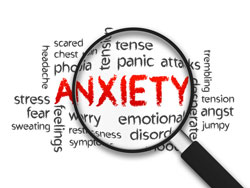 “Anxiety” derives from the Latin “anxietatem” and “anxious,” referring to a concerned, uneasy, troubled or anguished state of mind. Its contemporary, non-technical meaning is a feeling of worry, nervousness, or uneasiness, usually regarding some matter with an uncertain outcome, or in anticipation of an upcoming event. In the field of psychopathology, which clinical psychology and psychiatry are concerned about, anxiety is a concept of central importance.
“Anxiety” derives from the Latin “anxietatem” and “anxious,” referring to a concerned, uneasy, troubled or anguished state of mind. Its contemporary, non-technical meaning is a feeling of worry, nervousness, or uneasiness, usually regarding some matter with an uncertain outcome, or in anticipation of an upcoming event. In the field of psychopathology, which clinical psychology and psychiatry are concerned about, anxiety is a concept of central importance.
Generally speaking, the technical use of anxiety refers to the subjective experience of apprehensiveness, uncertainty and helplessness in response to some as yet unrecognized factor within the self, or to some event in the external environment. When associated with an external event, there is no actual threat of danger. In addition to the subjective feelings noted above, one is also typically aware of physiological changes, including irregular breathing, tension of the skeletal musculature (e.g., weakness, shakiness, stiffness, etc.), cardiovascular changes (e.g., rapid heart beat, palpitations, increased blood pressure), and gastrointestinal changes (e.g., nausea, diarrhea, vomiting).
While beyond the scope of this article to go into exhaustive detail, there are several major distinctions that have been drawn in the basic understanding of anxiety.
Anxiety Versus Fear
Where anxiety, by definition, is a response to an unrecognized stimulus, when the associated stimulus (either internal or external) is recognized, the subjective response is distinguished as a “fear.” The reader who recognizes that phobias, by definition, have known triggering stimuli may object to this distinction, since phobias are classified among the anxiety disorders. In a subsequent article on specific disorders, I will address why this is not a contradiction.
Manifest Versus Latent Anxiety
Manifest anxiety refers to the experience of the emotional and physiological signs of anxiety noted above. Latent anxiety refers to anxiety that is active but not seen. This latency may refer to one with a predisposition to respond with anxiety.
Conscious Versus Unconscious Anxiety
Conscious anxiety refers to the subjective anxiety response that the suffering individual can recognize and report feeling. Unconscious anxiety, by contrast, refers to physiological or behavioral expressions of anxiety in the absence of any feelings of being anxious. An individual who exhibits phobic avoidance without awareness of any feelings or physiological signs of anxiety could be described as exhibiting unconscious anxiety.
Primary Versus Signal Anxiety
Primary anxiety, in psychoanalytic theory, refers to the utterly overwhelming emotional experience exhibited when defense mechanisms fail to contain primitive and repressed material in the unconscious. This is commonly experienced in a very normal way in the occurrence of nightmares, where themes of fragmentation and annihilation are ubiquitous. Similar themes are also easily discerned in childrens’ stories like Humpty Dumpty, and in adult horror films where the most terrifying images are of victims pursued by forces of unseen but certain destructiveness. Signal anxiety is the internal warning mechanism, alerting the system to the stirrings in the unconscious that threaten equilibrium. Signal anxiety activates defense mechanisms to ensure primary anxiety does not intrude on consciousness.
This article has told you nothing about anxiety disorders that we hear about, such as social phobia, panic disorder, and obsessive compulsive disorder. Instead, the focus here has been to provide some conceptual and theoretical background to the anxiety construct as a basis for a discussion, in the next article, about specific anxiety disorders that you or those you know may have experienced.
If you need to get in touch with me to talk about anxiety therapy and counseling options just fill out a “contact us” form or call my office.